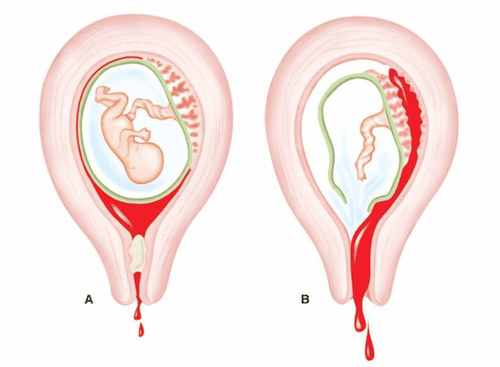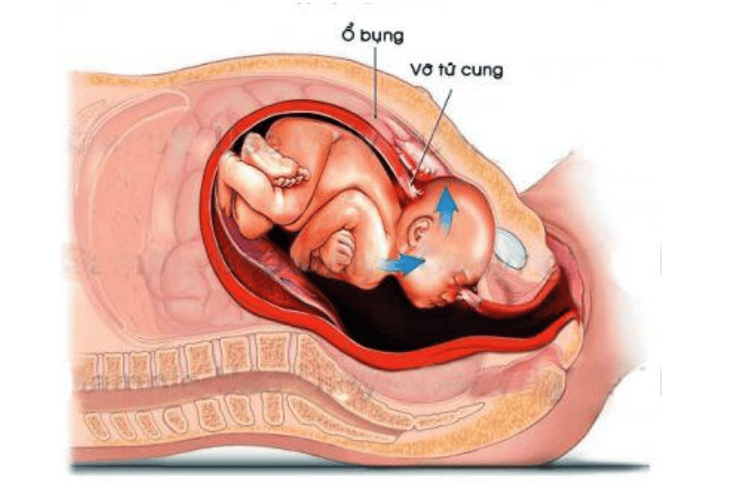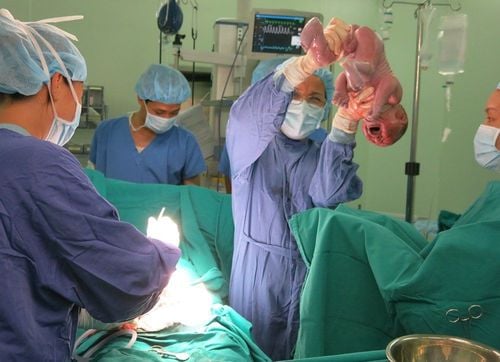This is an automatically translated article.
The article was professionally consulted by Doctor Department of Obstetrics and Gynecology - Vinmec Hai Phong International General Hospital.
Uterine rupture is a rare but dangerous obstetric complication, causing the mother's uterus to tear so that the fetus falls into the abdomen. As a result, the mother bleeds heavily and the baby can suffocate. Most of this occurs in women who have had a cesarean section scar from a previous cesarean section or scarring from other types of uterine surgery.
1. Causes of uterine rupture due to surgical scarring in the uterus
During labor, the intra-abdominal pressure increases as the fetus moves from the uterus to the vagina. This pressure can cause your uterus to tear. Usually, this tear will tear the scar from a previous cesarean section or surgery that took place in the uterus. When rupture occurs, all the contents of the uterus will run into the mother's abdomen, including the fetus.
That is why doctors may advise women who have had a previous cesarean section to avoid vaginal delivery in future pregnancies. However, it is still possible to give birth vaginally in some cases, but this would be a high risk factor and should be closely monitored.

2. Monitoring women with surgical scars in the uterus
The only way to prevent uterine rupture from uterine scarring is by cesarean section. However, you can still choose to have a vaginal delivery, but you need to discuss it with your doctor to make the best decision for you and your baby. Therefore, the doctor needs to know the maternity history, the surgery of the previous cesarean section and closely monitor the status of this pregnancy to predict whether the woman can give birth naturally or not.
Therefore, whatever precautions can be taken, women should take to prevent uterine rupture. This must begin even before the first pregnancy in women who have had previous uterine surgery due to fibroid removal, uterine accident.
Pregnant women should:
Get pregnant before the age of 30. Should choose cesarean section if prescribed by the doctor. Avoid pregnancy within 2 years after cesarean section. Follow the schedule of antenatal care, especially in the last three months of pregnancy. If you have any unusual symptoms, such as sudden abdominal pain, decreased fetal movement, etc., you should contact your doctor immediately. Although the expected delivery date has come, but there are still no signs of labor, the mother still has to go to the hospital to be monitored. The doctor should:
Determine if the woman is at high risk of uterine rupture. Use ultrasound to evaluate the condition of the uterus. Inform and advise mothers with detailed information about the condition and possible risks of vaginal and cesarean deliveries to help mothers make the most informed decisions. Monitor fetal heart rate and fetal movement. Promptly diagnose and treat any health problems, like uterine rupture.

Uterine rupture can have serious consequences, so when both the mother and the doctor are aware and alert, this complication can be prevented or treated successfully.
At Vinmec International General Hospital, there is a package maternity service as a solution to help pregnant women feel secure because of the companionship of the medical team throughout the pregnancy. When choosing Maternity Package, pregnant women can:
The pregnancy process is monitored by a team of qualified doctors Regular check-up, early detection of abnormalities Maternity package helps to facilitate the process. Childbirth program Newborns receive comprehensive care
Please dial HOTLINE for more information or register for an appointment HERE. Download MyVinmec app to make appointments faster and to manage your bookings easily.
Reference source: Healthline.com; Rossfellercasey.com













